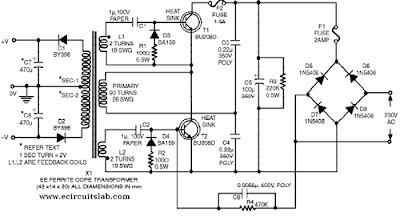The SMPS described here is suit-able for high-wattage stereos and other similar equipment. The circuit employs two high-voltage power transistors (BU208D) which have built-in re-verse-connected di-odes across their collectors and emitters. It can supply about 250-watt out-put. The circuit uses a ferrite core transformer of 14mm width, 20mm height, and 42mm length of E-E cores. An air gap of 0.5 mm is required between E-E junction. Good insulation using plastic-insulating sheets (Mylar) is to be maintained between each layer of winding.
Switch Mode Power Supply Circuit Diagram

The number of primary turns required is 90 with 26 SWG wire. The secondary winding employs 17 SWG wire (for 4A load current). Each turn of the secondary develops approximately 2 volts. The reader can decide about the output volt-age and the corresponding secondary turns, which would work out to be half the desired secondary voltage. The volt-age rating of capacitors C7 and C8 should be at least twice the secondary output of each secondary section. BY396 rectifier diodes shown on the secondary side can be used for a maximum load current of 3 amperes.
Two feedback windings (L1 and L2) using two turns each of 19 SWG wire are wound on the same core. These windings are connected to transistors T1 and T2 with a phase difference of 180o, as shown by the polarity dots in the figure. First wind the primary winding (90 turns using 26 SWG wire) on the former. Then wind the two feedback windings over the secondary (output). Ensure that each winding is separated by an insulation layer. Two separate heat sinks are to be pro-vided for the two transistors (BU208D).
The filter capacitor for mains should be of at least 47µF, 350V rating. It is better to use a 100µF, 350V capacitor. If the output is short-circuited by less than 8-ohm load, the SMPS would automatically turn off because of the absence of base current. The hfe min (current amplification factor) of BU208D is 2.5. Thus, sufficien base current is required for fully satu rated operation, otherwise the transistors get over-heated. At times, due to use of very high value of capacitors C7 and C8 (say 2200mF or so) on the secondary side or due to low load, the oscillations may cease on the primary side. This can be rectified by increasing the value of capacitor C6 to 0.01mF.
Author : Deepu P.A
Comments
Post a Comment